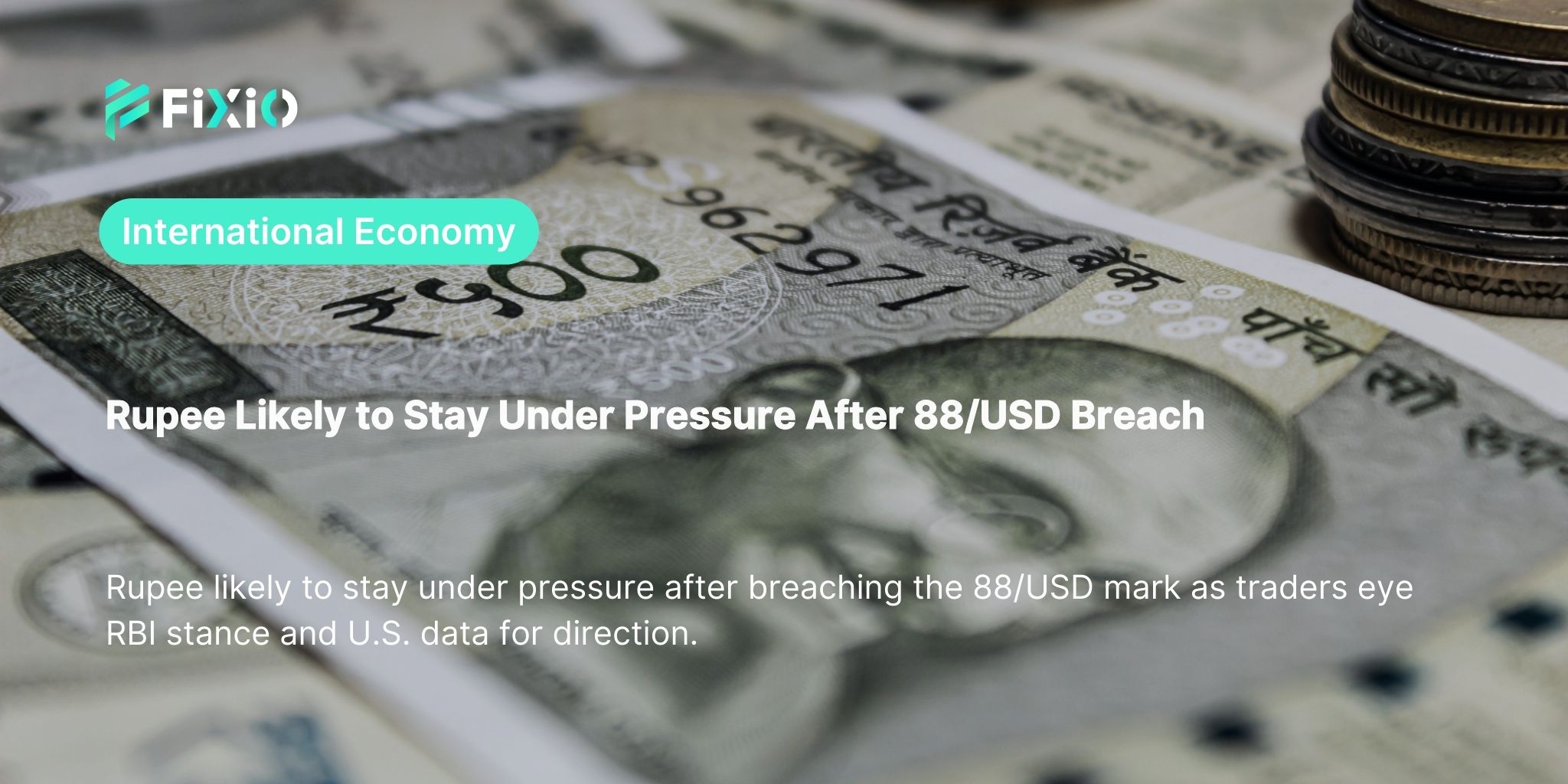
The Rupee likely to stay under pressure after breaching the critical 88/USD mark last week, raising concerns among traders, policymakers, and investors. The sudden slip past this psychological barrier highlights vulnerabilities in India’s currency market and intensifies speculation about how the Reserve Bank of India (RBI) may respond in the coming days.
The Indian rupee’s fall to a record low of 88.30 per dollar shocked many market participants. For months, traders expected the RBI to step in aggressively to defend the currency. Instead, the central bank appeared to adopt a measured stance, allowing the breach to occur. This decision emboldened speculators, who now see further downside potential. Analysts suggest that multiple factors played into the RBI’s muted reaction. Heavy equity outflows from foreign investors, persistent importer dollar demand, and speculative pressures all combined to weaken the rupee. In fact, Friday alone saw nearly $950 million in equity sales, a sharp reminder of India’s exposure to global capital flows.
Once a key level like 88 is broken, the psychology of the market often shifts. Traders who were previously cautious become more aggressive, betting that further weakness is inevitable. This can create a self-reinforcing cycle where selling pressure feeds on itself. One senior treasury official noted that the “risk-reward on the rupee is now decisively skewed to the downside.” Speculators also tend to watch for signals from the RBI. If the central bank is seen as reluctant to defend a particular level, they push harder against the currency. Market participants are now keenly focused on identifying where the RBI might draw its next “line in the sand.”
Interestingly, India’s GDP growth surprised on the upside in the June quarter, beating forecasts. However, economists caution that the improvement may not provide lasting support for the rupee. Madhavi Arora, lead economist at Emkay Global, pointed out that much of the growth was driven by temporary factors: exceptionally soft deflators, front-loaded government spending, and export shipments made ahead of new U.S. tariffs. These drivers may reverse in coming quarters. At the same time, India faces challenges from global developments. The imposition of additional U.S. tariffs last week is a case in point. Such measures can weigh on India’s trade balance and put further pressure on the currency. The rupee’s trajectory, therefore, is shaped not just by domestic conditions but by broader international dynamics.
It is not only the rupee that is under stress. Most Asian currencies weakened at the start of the week, leaving little regional support. When currencies across Asia decline, it becomes more difficult for any single country to resist the trend without heavy intervention. This regional weakness reflects concerns about slowing global growth, trade disruptions, and expectations for U.S. monetary policy.
Another major factor shaping the rupee’s outlook is the path of U.S. interest rates. Investors are awaiting a raft of U.S. labor data this week, including job openings, private payrolls, and the closely watched nonfarm payrolls report. These indicators will guide expectations for how deeply the Federal Reserve will cut rates this year. If U.S. data remain strong, the dollar could stay firm, adding more pressure on emerging market currencies like the rupee.
Despite the challenges, there are potential stabilizing factors. If the RBI decides to intervene more aggressively in the foreign exchange market, it could provide a floor for the rupee. India’s strong foreign exchange reserves give the central bank considerable firepower. Additionally, if global risk appetite improves and foreign investors return to Indian equities, demand for the rupee could recover. However, these are uncertain possibilities. For now, the breach of 88 has shifted sentiment decisively, and market participants are bracing for further volatility.
For traders, the recent move underscores the importance of monitoring both domestic and international developments. Currency markets are influenced by a complex mix of factors: capital flows, trade balances, central bank actions, and global economic conditions. Investors who ignore these interconnections risk being caught off guard. Moreover, the breach of critical psychological levels often marks a turning point in market sentiment. Whether the rupee stabilizes or continues to slide may depend on the RBI’s next moves and how the global macro environment evolves.
In summary, the Rupee likely to stay under pressure after breaching the 88/USD mark, with downside risks dominating near-term expectations. Speculative pressures, regional currency weakness, and U.S. dollar strength all point to continued challenges for India’s currency. The market will be closely watching the RBI’s response and key U.S. labor market data for further direction. Stay informed with the latest Forex trading news and analysis. Visit our website now at: https://fixiomarkets.com/en/prex-blogs
Rupee likely to stay under pressure after breaching the 88/USD mark as traders eye RBI stance and U.S. data for direction.
Superior trade execution & trading conditions with the NDD method.

The online FX industry provides a platform for investors worldwide to engage in the buying and selling.

Subscribe to our daily newsletter and get the best forex trading information and markets status updates
Trade within minutes!
Comment (0)